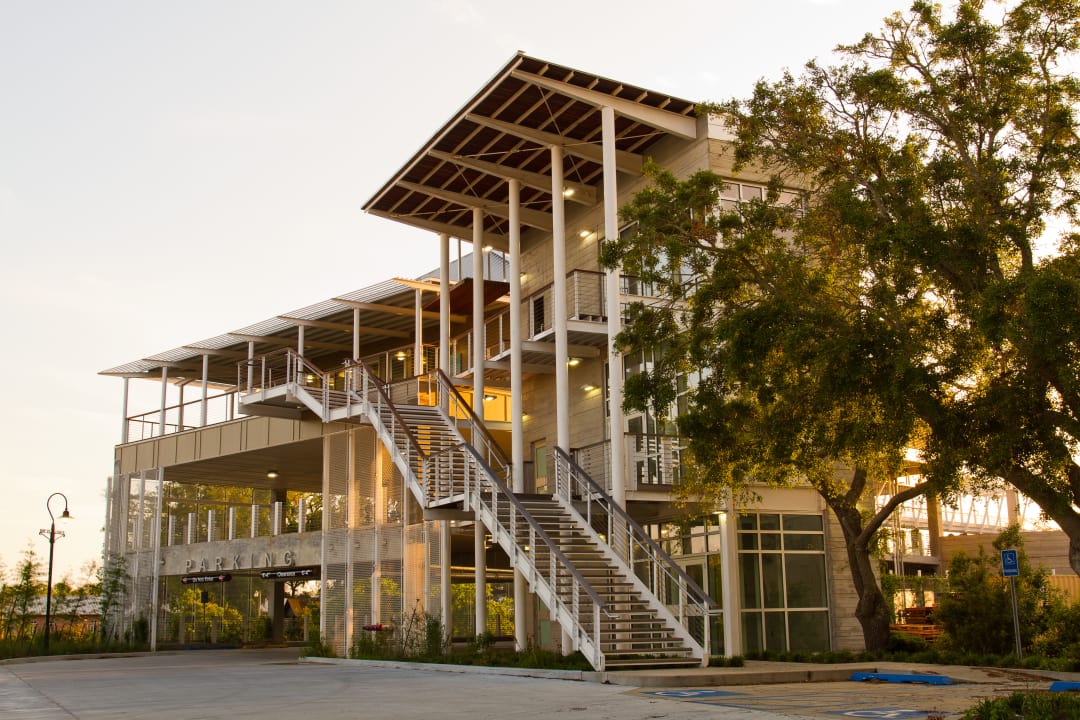By Allison H. Anderson, FAIA

AFTER HURRICANE KATRINA, BAY ST. LOUIS, MS PRIORITIZED REBUILDING CITY INFRASTRUCTURE OUTSIDE OF FLOOD ZONES. THE CITY PLACED CIVIC CENTER ATOP A PARKING GARAGE WITH PHOTOVOLTAIC PANELS TO PROVIDE UNINTERRUPTIBLE POWER AND RAINWATER CAPTURE.
How you can create a more livable building by understanding your risks and paying attention to details
Building safety is one of the measures of a secure, healthy community and a foundational element to enhance resilience. Building codes were developed to provide minimum standards for public health and safety and have since evolved to address hazards and disasters. However, the limited level of property protection provided by the building code may not address a client’s building performance objectives. After all, the safest, most sustainable, and best performing building is one that doesn’t end up in a landfill.
Understanding potential risks at a project site, selecting appropriate materials, and crafting details that address potential vulnerabilities enhance a building’s resilience and community’s ability to recover from adverse events. Embarking on a new project with safety and performance as top priorities can help buildings and communities thrive.
Know your risk
Understanding risks at a project site is a good place to start, as performance goals should align with the potential hazards that threaten a location. Certain strategies may be useful against more than one type of hazard, but sometimes strategies can conflict with one another. For instance, a continuous load path for hurricane-resistance can also help against lateral movement in earthquake zones, but raising first floor levels against flooding can create a “soft story” prone to collapse in an earthquake.
Architects traditionally analyze site conditions like prevailing winds, presence of water, and orientation to the sun, but now must consider the potential for changes in climate. Community hazard mitigation plans and trustworthy sources for future climate scenarios, such as the US Climate Resilience Toolkit’s Climate Explorer, provide a basis for identifying long-term risks.
Architects can communicate foreseeable hazards to the client, but the client is ultimately responsible for determining building performance goals and defining mission-critical functions. Oftentimes, these goals will mean going beyond the building code. If a building will be occupied during or immediately following a disaster, it may need to meet a higher standard of protection. Additional measures can be taken to reduce a building’s vulnerability if the consequences for interruption are severe economic loss or the failure of an essential service.
Be thoughtful about materials
Materials are critical to occupant comfort and safety, but can also protect the building from damage. Early in the design process, architects can identify appropriate materials that mitigate risks. Examples include:
- Sea level rise and intense rainfall can cause flooding beyond mapped flood zones. A commercial building might include wet-floodproofing materials that can be easily cleaned, restoring the building to use quickly after inundation.
- Changes in rainfall patterns may lead to droughts and place more buildings at risk of wildfires. In this situation, a residence could substitute a shingle roof with concrete composite tile to reduce the chance of embers igniting the roof.
- The number of days with temperatures over 90 degrees is increasing. Outdoor play areas at schools can be designed to reduce the heat island effect and heat gain with permeable paving.
Pay extra attention to details
Careful detailing is necessary for high-performance buildings. A resilient building will have a long service life, excellent environmental separation, low-maintenance cladding, and systems and assemblies that allow for rapid replacement.
Architects are witnesses to the success or failure of building details. Many continue to advance knowledge in the profession regarding adaptation measures to reduce casualties and property damage in hazard events. Research in wind tunnels, fire-safety labs, and debris impact test facilities evaluate promising new technologies, while post-disaster assessments identify the points of failure for structures that could not meet the hazard’s intensity.
Reduce the impact of hazards by paying additional attention to the following building elements:
- Create a continuous load path to help hold the structural frame together when earthquakes or high winds exert lateral forces on a building. Strong joints between the roof, walls, floors, and foundation connect the frame into a system that resists sliding and overturning.
- A standard building envelope is designed to improve thermal comfort and prevent moisture transmission, but may not be prepared for extreme temperatures and intensive rainfall events. Prevent thermal bridging, add window shading, provide generous overhangs, and utilize continuous air barriers to combat extreme temperatures and heavy rains.
- Hurricanes often peel off roof coverings that are inadequately fastened. To avoid this, strengthen roof sheathing and materials, seal the roof deck, and improve flashing.
- When flood waters meet an obstruction, more damage can occur than if the water could pass through. Flood vents and breakaway walls can prevent structural damage and limit recovery to cleaning up rather than rebuilding.
- Wildfires can spread through unprotected eaves and soffits. Flat profile soffits with non-combustible materials, fire-suppressing vents, careful joint sealing, and limited overhangs reduce the chance of sparks entering an attic.
Learn more about designing for resilience and receive continuing education credit on AIAU with our Resilience and Adaptation course series. You can also explore AIA Best Practices for information on how to navigate codes and standards.
Allison H. Anderson, FAIA, is a principal at unabridged Architecture specializing in resilience and climate adaptation. She is a member of the AIA Resilience Education Working Group.
Image credits
 Eugenia Uhl
Eugenia Uhl
Leave a comment